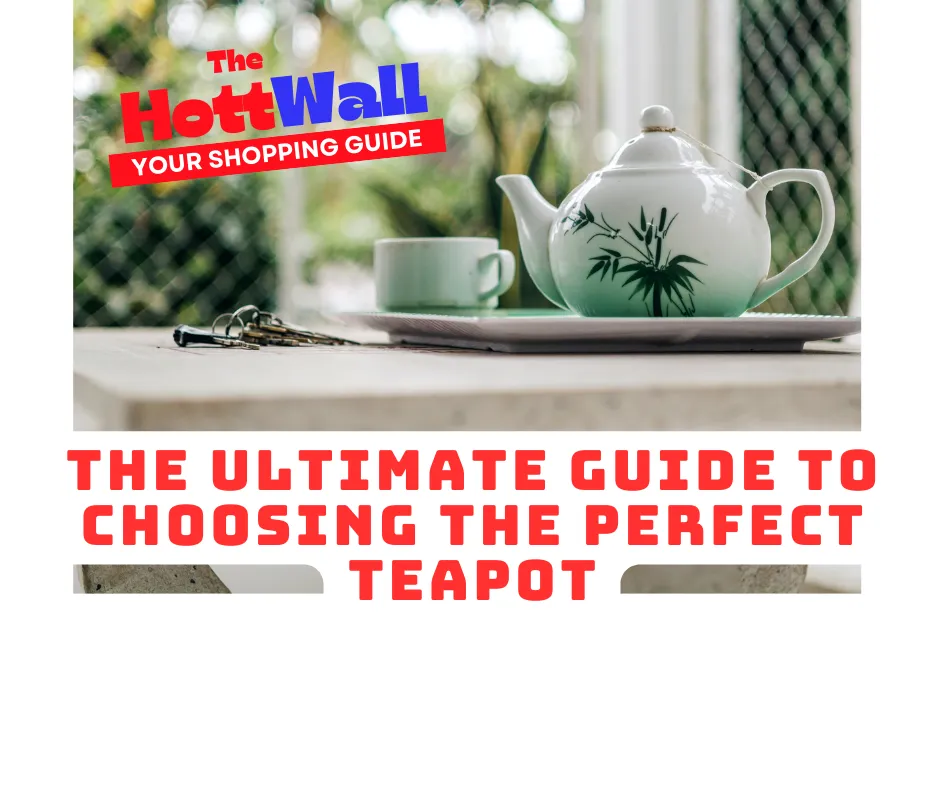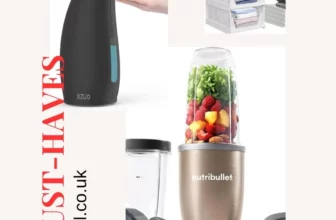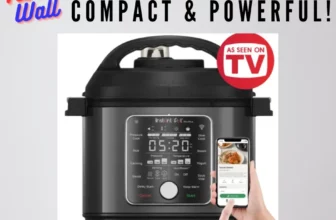
Introduction
A teapot is more than just a vessel for brewing tea; it’s an essential part of the tea-drinking experience, symbolizing tradition, hospitality, and comfort. Whether you enjoy a quiet cup alone or serve tea to guests, the right teapot can significantly enhance both the flavor and presentation of your tea. In this comprehensive guide, we’ll delve into the various types of teapots available, their materials, and the factors to consider when choosing and caring for the perfect teapot to suit your needs. By the end, you’ll be equipped with the knowledge to select a teapot that complements your lifestyle and enhances your tea-drinking rituals.

Table of contents
Types of Teapots:
Teapots come in a variety of styles, each with its own unique features and benefits. Understanding the different types will help you make an informed decision that aligns with your personal tea preferences and brewing habits.
Traditional
Traditional teapots are often made from materials like porcelain, ceramic, or cast iron, and feature a spout, handle, and lid. These teapots provide a classic look and feel, making them a beloved choice for tea enthusiasts who appreciate the ritual of brewing tea by hand. Traditional teapots are versatile and can range from simple, everyday designs to intricate, decorative pieces that are perfect for special occasions or as collector’s items.
Electric
Electric teapots, also known as electric kettles, combine the functionality of a teapot with the convenience of an electric appliance. These teapots are designed to heat water quickly and efficiently, often featuring temperature control settings that allow you to brew various types of tea at the ideal temperature. This makes electric teapots a great choice for those who enjoy different varieties of tea, such as green, black, and herbal teas, each of which requires specific brewing temperatures for the best flavor.
Glass
Glass teapots are prized for their aesthetic appeal, allowing you to watch the tea leaves unfurl and the water change color as it brews. Made from heat-resistant borosilicate glass, these teapots often come with a built-in infuser, making them ideal for brewing loose leaf tea. Glass teapots are particularly well-suited for delicate teas like green or white tea, where visual appreciation is part of the experience. Additionally, the transparent nature of glass teapots makes them a stylish addition to any kitchen or dining table.
Travel
For tea lovers on the go, travel teapots offer a convenient way to enjoy a fresh cup of tea wherever you are. These teapots are typically compact, lightweight, and designed with features like built-in strainers or double-wall insulation to keep your tea hot. Travel teapots are perfect for taking to the office, on trips, or even for a quick tea break outdoors. Despite their small size, they can deliver the same quality of brewed tea as a full-sized teapot.
Materials of Teapots
The material of a teapot plays a crucial role in the brewing process and can significantly impact the flavor of your tea. Below are some of the most common materials used in teapot manufacturing, each with its own set of advantages and disadvantages.
Ceramic
Ceramic teapots are highly favored for their excellent heat retention and durability. They are particularly well-suited for brewing black and herbal teas, as they maintain a consistent temperature, which is key for extracting the full flavor of the tea leaves. Ceramic teapots also come in a wide variety of colors and designs, making them both functional and decorative.
Advantages:
- Excellent heat retention
- Wide variety of designs and colors
- Durable and long-lasting
Disadvantages:
- Can be heavy
- Prone to chipping or cracking if not handled carefully
Porcelain
Porcelain teapots are known for their delicate appearance and smooth finish. Typically white or lightly decorated, they are excellent for brewing more delicate teas like green or white tea, where the fine, non-porous surface of the porcelain ensures an even brewing temperature without absorbing any of the tea’s flavors or aromas.
Advantages:
- Elegant and refined look
- Smooth, non-porous surface
- Retains heat effectively
Disadvantages:
- Can be more expensive
- Fragile and requires careful handling
Cast Iron
Cast iron teapots, also known as tetsubin, are traditional Japanese teapots that are renowned for their durability and superior heat retention. These teapots are typically coated with enamel on the inside to prevent rusting and to ensure the pure flavor of the tea. Cast iron teapots are ideal for brewing robust teas like black and oolong teas, where the steady, even heat enhances the richness of the tea.
Advantages:
- Superior heat retention
- Durable and long-lasting
- Adds a traditional, rustic aesthetic to your tea experience
Disadvantages:
- Heavy and cumbersome to handle
- Requires special care to prevent rusting
Glass
Glass teapots are perfect for those who enjoy the visual aspect of tea brewing. Made from borosilicate glass, which is resistant to thermal shock, these teapots allow you to see the tea brewing process in action. Glass teapots are versatile and suitable for all types of tea, but they are particularly popular for blooming teas and other visually appealing varieties.
Advantages:
- Aesthetic appeal; allows you to see the tea brewing
- Non-reactive material, preserving the pure taste of the tea
- Easy to clean
Disadvantages:
- Can be fragile and prone to breaking
- Doesn’t retain heat as well as other materials
Stainless Steel
Stainless steel teapots are modern, durable, and often feature sleek, contemporary designs. They are known for their ability to keep tea hot for longer periods, and they are easy to clean, making them a practical choice for everyday use. Stainless steel teapots are versatile and suitable for brewing all types of tea, though some may impart a slight metallic taste if not of high quality.
Advantages:
- Durable and resistant to damage
- Retains heat well
- Easy to clean and maintain
Disadvantages:
- Can impart a metallic taste if not high quality
- Limited in design variety compared to ceramic or porcelain
How to Choose the Best Teapot
Selecting the best teapot involves considering several factors, including your tea-drinking habits, aesthetic preferences, and the specific features that matter most to you.
Capacity
Think about how much tea you typically brew. If you often entertain guests or enjoy multiple cups throughout the day, a larger teapot with a capacity of 1 liter or more may be ideal. For individual use, a smaller teapot with a capacity of 500 ml to 750 ml might be more practical.
Design and Aesthetics
Your teapot should not only be functional but also reflect your personal style. Whether you prefer a minimalist design, a vintage look, or something more ornate, there is a teapot to suit your taste. Consider how the teapot will fit with your kitchen decor or dining set.
Infuser or Strainer
If you enjoy loose leaf tea, a teapot with a built-in infuser or strainer can be incredibly convenient. These features make it easy to brew your tea without needing separate accessories. If you prefer using tea bags or already own a tea infuser, you might opt for a teapot without this feature.
Heat Retention
The material of your teapot will largely determine how well it retains heat. Cast iron and ceramic teapots excel in this area, making them great for keeping your tea hot for extended periods. Glass and stainless steel also offer good heat retention but with a different aesthetic and feel.
Caring for Your Teapot
Proper care and maintenance can extend the life of your teapot and ensure the best tea flavor.
Cleaning
Always clean your teapot after each use to prevent the buildup of stains and flavors. For most teapots, warm water and mild soap are sufficient. Avoid using harsh abrasives or metal scouring pads that can scratch or damage the surface. For cast iron teapots, simply rinse with warm water and dry thoroughly to prevent rust.
Storage
Store your teapot in a dry, cool place when not in use. Make sure it is completely dry before storing to prevent mold and mildew. For teapots with lids, it’s a good idea to store them with the lid slightly ajar to allow air circulation.
Special Care
Some teapots, particularly those made from cast iron or unglazed clay, may require special care. Follow the manufacturer’s instructions to maintain these teapots properly. For example, cast iron teapots should never be placed in a dishwasher, and unglazed clay teapots may need to be seasoned before their first use.
Conclusion
Choosing the right teapot can significantly enhance your tea-drinking experience, making it more enjoyable and flavorful. Whether you prefer the classic appeal of a ceramic teapot, the modern design of a glass teapot, or the durability of cast iron, there’s a perfect teapot for everyone. By considering factors such as capacity, material, design, and care requirements, you can find a teapot that not only meets your functional needs but also complements your personal style and kitchen decor. With the right teapot, you can elevate your tea rituals and enjoy a perfect cup of tea every time.
FAQ’s for the Perfect Teapot
Can I use my teapot on the stovetop?
Most traditional teapots are not designed for direct stovetop use. Electric teapots and specific stovetop-safe models are exceptions. Always check the manufacturer’s guidelines.
How do I remove tea stains from my teapot?
To remove tea stains, soak the teapot in a mixture of warm water and baking soda or use a gentle scrub with vinegar. Rinse thoroughly afterward.
Is a glass teapot safe to use with boiling water?
Yes, most glass teapots are made from heat-resistant borosilicate glass and can safely handle boiling water. However, always check the manufacturer’s specifications.
Can I brew coffee in a teapot?
While you can brew coffee in a teapot, it’s generally not recommended as the flavors can linger and affect your tea’s taste. Use separate equipment for coffee to maintain the pure flavor of your tea.
How do I prevent my cast iron teapot from rusting?
To prevent rust, rinse your cast iron teapot with warm water only and dry thoroughly after each use. Avoid using soap or abrasive cleaners.









[…] the guesswork associated with traditional gardening. Many models are compact enough to fit on a kitchen countertop, windowsill, or shelf—perfect for small apartments or urban […]